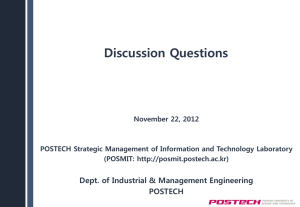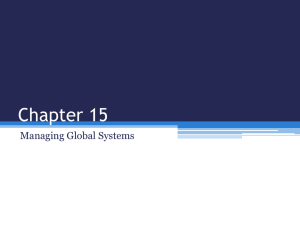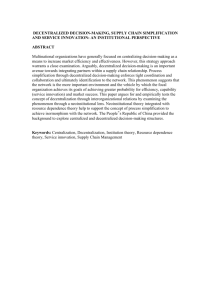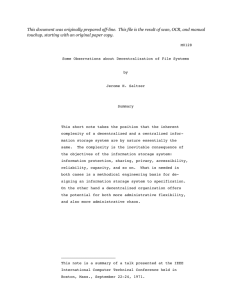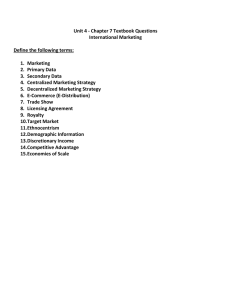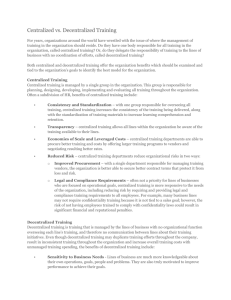C : D I T
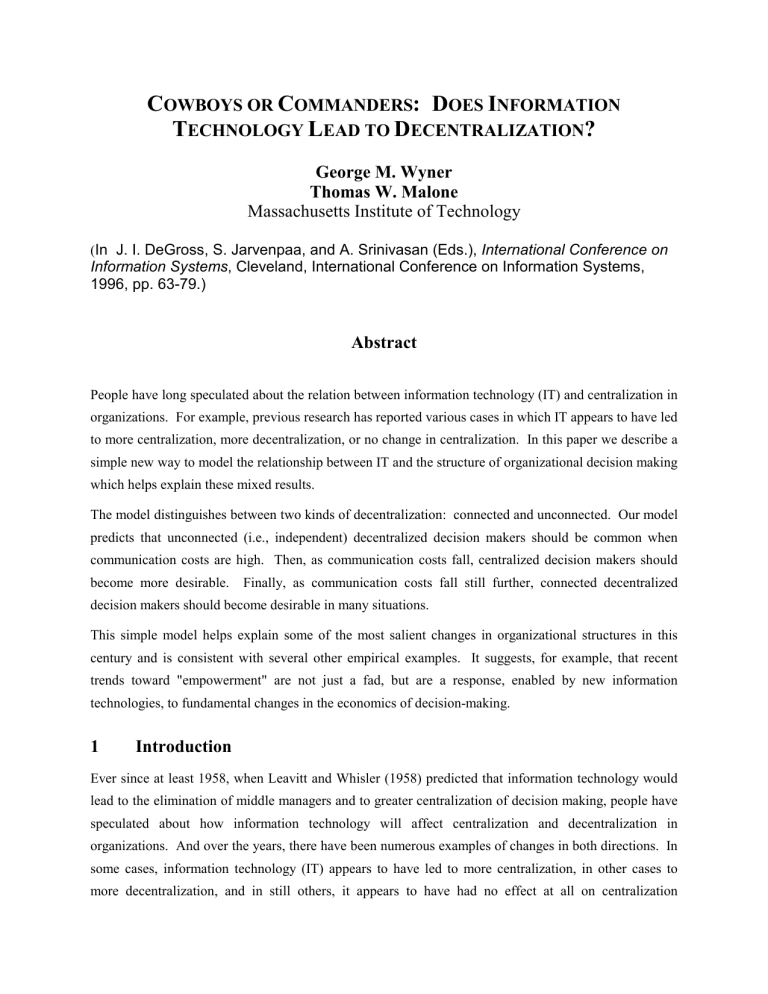
C
OWBOYS OR
C
OMMANDERS
: D
OES
I
NFORMATION
T
ECHNOLOGY
L
EAD TO
D
ECENTRALIZATION
?
George M. Wyner
Thomas W. Malone
Massachusetts Institute of Technology
(
In J. I. DeGross, S. Jarvenpaa, and A. Srinivasan (Eds.), International Conference on
Information Systems , Cleveland, International Conference on Information Systems,
1996, pp. 63-79.)
Abstract
People have long speculated about the relation between information technology (IT) and centralization in organizations. For example, previous research has reported various cases in which IT appears to have led to more centralization, more decentralization, or no change in centralization. In this paper we describe a simple new way to model the relationship between IT and the structure of organizational decision making which helps explain these mixed results.
The model distinguishes between two kinds of decentralization: connected and unconnected. Our model predicts that unconnected (i.e., independent) decentralized decision makers should be common when communication costs are high. Then, as communication costs fall, centralized decision makers should become more desirable. Finally, as communication costs fall still further, connected decentralized decision makers should become desirable in many situations.
This simple model helps explain some of the most salient changes in organizational structures in this century and is consistent with several other empirical examples. It suggests, for example, that recent trends toward "empowerment" are not just a fad, but are a response, enabled by new information technologies, to fundamental changes in the economics of decision-making.
1 Introduction
Ever since at least 1958, when Leavitt and Whisler (1958) predicted that information technology would lead to the elimination of middle managers and to greater centralization of decision making, people have speculated about how information technology will affect centralization and decentralization in organizations. And over the years, there have been numerous examples of changes in both directions. In some cases, information technology (IT) appears to have led to more centralization, in other cases to more decentralization, and in still others, it appears to have had no effect at all on centralization
Wyner and Malone
(Attewell and Rule 1984; George and King 1991). Based on previous research, therefore, there appears to be no clear answer to the question of how IT affects centralization and decentralization of organizations.
In this paper we describe a new way to model the relationship between IT and the structure of organizational decision making which helps explain the mixed results reported in the literature. Our model predicts that IT will sometimes lead to greater centralization and sometimes to decentralization, and it describes circumstances under which each of these effects can be expected.
The critical insight captured in the model is that the traditional debate about IT and centralization lumps together two kinds of decentralization which have very different communication requirements. When we distinguish between decentralized control by unconnected (i.e., independent) decision makers and decentralized control by connected decision makers, a clearer pattern begins to emerge (cf. Anand &
Mendelson (1995)). Our model predicts that unconnected decentralized decision makers should be common when communication costs are very high. Then, as communication costs fall, centralized decision making should become more desirable. Finally, as communication costs fall still further, connected decentralized decision making should become desirable in many situations.
The basic logic of this progression derives from two simple assumptions:
(1) new information technologies will significantly reduce the costs of communication, and
(2) each stage in this progression requires more communication than the previous one, but--at least in some situations--has some other advantages over the previous stage.
Thus, as communication costs decrease, there will eventually come a point for each stage where its other advantages over the previous stage will be more important in some situations than its (diminishing) communication cost disadvantage.
Of course, there are very many factors in addition to IT that affect centralization and decentralization in organizational decision-making. In fact, many researchers have suggested that the mixed results concerning IT and degree of centralization are symptomatic of a fundamental flaw in the notion that IT constitutes a "technological imperative" which somehow dictates the choice of organizational structure
(Barley 1986; Kling 1980; Markus and Robey 1988; Orlikowski 1992). For example, it is often more useful to consider IT as a choice to be made, a managerial decision which both influences and is influenced by a complex field of social, political, and other forces (George and King 1991). Among the many factors that can influence the uses of IT in an organization, for instance, are: the prior distribution of power within the organization, patterns of interpersonal trust, locations of decision-relevant information, personal motivations, agency costs, "absorptive capacity" of decision makers, government regulations, national cultures, organizational traditions, and individual personalities (Cohen and
2
Cowboys or Commanders
Levinthal 1990; DiMaggio and Powell 1983; Galbraith 1977; Gurbaxani and Whang 1991; Huber and
McDaniel 1986; Malone 1995; Markus 1983; Schein 1985; Scott 1992; Thompson 1967).
To arrive at a deep understanding of the role IT plays in organizational structure, however, one must view IT, not only as a choice to be made by a particular organization, but also as a resource in the environment which constrains and enables the choices of many organizations over time (Orlikowski
1992). The model we present in this paper analyzes one simple--but important--aspect of this relationship. It focuses on the logical relationship between reductions in communication costs that are enabled by IT and the relative economic efficiency of various decision making structures. Of course, economic efficiency is not the only factor which influences the choice of centralization and decentralization in particular organizations, but it is often an important one.
Understanding this relationship is useful for three reasons. First, this surprisingly simple model helps us understand conceptually what the effects of reduced communication costs would be if all other factors remained constant. Second, it provides a possible explanation for a variety of empirical facts, such as broad historical trends in organizational structures over the last century. Finally, to the degree that one believes IT-enabled reductions in communication costs are likely to be a significant factor in the future, our argument suggests an effect this factor is likely to have. Whether this factor actually turns out to be important is, of course, uncertain, but our simple model provides a principled basis for prediction. To the degree the pattern predicted by our model does not occur, the model highlights the importance of looking to other factors for an explanation of what actually happened. Our model is particularly intriguing in this regard because, unlike previous models of this question (Gurbaxani and Whang 1991), it shows how a simple model can explain changes in both directions while nevertheless predicting a broad long-run change in one direction.
Whenever an organization takes some action (such as selling a product, designing a product, or hiring an employee), the organization must somehow decide to take that action instead of any of the other possible actions (including "doing nothing") which it might have taken. Our model of organizational decision making focuses on where these decisions are made and the information that is used in making them. In general, there are various sources of information that are of potential value in making a decision. Some of these information sources are "local" to the action; others are "remote" (e.g., located in some other person, group, or physical location).
Decision making structures
We consider two primary characteristics of the decision making structures associated with a set of actions: centralization and connectivity. We define a decentralized decision making structure as one in
3
Wyner and Malone which the decisions are made at the place the action is taken and a centralized decision making structure as one in which the decisions for a set of distributed actions are all made at the same place. Similarly, we define a connected decision making structure as one in which decisions about an action are made using remote as well as local information, and an unconnected decision making structure as one in which decisions about an action are made without access to remote information. These two dimensions give rise to the four structures depicted in Figure 1.
In the analysis which follows, we will focus on three of these four structures. The fourth, the unconnected centralized case seems much less likely to be desirable: for example, while headquarters could set local store prices without even looking at local sales histories, such decisions would, in many cases, be significantly worse than those arrived at under the other structures (where local information is taken into account). (See Wyner & Malone (1996) for a more detailed analysis of this case.)
Connected
Connectivity
Unconnected
Centralized Decentralized
Degree of Centralization
Figure 1 . Four possible decision making structures
Figure 2 shows simplified representations of the three basic types of decision making structures we are considering: independent decentralized decision makers (i.e. the unconnected decentralized structure), centralized decision makers (i.e. the connected centralized structure), and connected decentralized decision makers. We will sometimes also refer to the decision makers in these three structures as
"Cowboys," "Commanders," and "Cyber-cowboys," respectively. These "nicknames" are not only a convenient shorthand, but are also intended to provide some intuition for each structure by calling to mind archetypal figures which embody the three kinds of decision makers. The "Cowboy," alone on a horse, must make independent decisions, based only on what can be seen and heard in the immediate environment. The "Commander" controls troops from a distance, using remote information from scouts, battlefield reports, and other sources. Finally, the "Cyber-cowboy" makes autonomous decisions like a cowboy, but does so based on potentially vast amounts of remote information available through electronic or other networks.
4
Cowboys or Commanders o o o o o o o o o o o o x o o o o o o o o o o o o
Independent decentralized decision-makers
("Cowboys")
Centralized decision-makers
("Commanders")
Connected decentralized decision-makers
("Cyber-cowboys")
Figure 2. Three simple alternatives for decision making structures
(Key: o = places where actions are taken and information is generated x = centralized decision maker.)
Independent decentralized decision makers ("Cowboys")
Independent decentralized decision makers, by definition, have relatively low needs for communication.
For example, if local store managers set prices or local bankers approve loans using only the information available to them locally, they don't need nationwide information systems, long distance telephone conversations, and so forth.
The price such independent decision makers pay for their simplicity of decision making is that their decisions are relatively uninformed. They don't know what is happening elsewhere, they can't learn from the experiences of people outside their local environment, and they can't easily pool resources or take advantage of economies of scale.
Centralized decision makers ("Commanders")
Centralized decision makers, on the other hand, are likely to have significantly higher communication needs than independent decentralized decision makers. In order to make informed decisions,
"Commanders" need to have information from a number of diverse sources. For instance, if Wal-Mart prices or bank advertising strategies are set at a national level, the people who make these decisions should at least have some kind of sales histories for the products they are selling, and much more detailed information about consumer preferences in different areas could be quite helpful.
One advantage of this centralized decision making, of course, is that by taking more information into account, better decisions can be made. Pricing and promotion experiments can be run in a few stores, and then their results can be used in others. Best suppliers can be identified, and economies of scale can be captured. Best practices can be shared between stores.
5
Wyner and Malone
Connected decentralized decision makers ("Cyber-cowboys")
Connected decentralized decision makers generally require even more communication than centralized ones. In this case, relevant information needs to be brought, not just to one central point, but to all the decentralized decision makers. For instance, Edward D. Jones & Co., a retail brokerage firm based in St.
Louis has all its 3,100 sales representatives nationwide reporting directly to the national head of sales.
This very "flat" organization makes heavy use of information technology. For instance, sales reps update files and download new product information from computers in St. Louis, and they make frequent calls to headquarters about client problems and questions (Keenan 1994).
Even more extreme examples of connected decentralized decision making occur all the time in the interactions among buyers and sellers in a market. Whenever a company chooses to buy a product or service from an outside supplier, rather than to make it internally, it is using the decentralized structure of the marketplace--rather than its internal hierarchical structure--to coordinate production. In many cases, these market-based structures are cheaper, faster, or more flexible than internal production (Malone,
Yates and Benjamin 1987).
What factors affect where decisions are made?
To understand how IT affects centralization and decentralization we must understand how IT is related to factors that can affect the relative performance of the three decision making structures just described. As noted in the introduction, there are many factors that affect how decision making power is distributed in organizations. (See Malone (1995) for a brief summary of how three of these factors--decision information, trust, and motivation--are related to centralization and decentralization.)
Even though many factors can affect centralization and decentralization, the trade-offs among our three decision making structures are particularly clear for two factors related to decision information: (1) the value of the remote decision information used (i.e., the cost of not considering it) and (2) the costs of communicating the remote decision information. As shown in Table 1, "Cowboys" should, in general, have the lowest communication costs (because they do the least communicating), followed by
"Commanders," and then "Cyber-cowboys," each of which communicates more than its predecessor.
Furthermore, both "Commanders" and "Cyber-cowboys" realize the benefits of considering remote information which the "Cowboys" ignore.
6
Cowboys or Commanders
Decision making structure Costs of communicating remote decision information
Benefits of considering remote decision information
All other costs
(including trust, motivation, etc.)
L L ? Independent decentralized
("Cowboys")
Centralized
("Commanders")
Connected decentralized
("Cyber-cowboys")
M H ?
H H ?
Table 1 . Summary of costs for various decision making structures
In comparing the three structures, Table 1 also has a column for "all other costs" which includes, for example, the costs of actually making decisions (e.g., the salaries of decision makers), the costs of economies of scale (or the lack thereof), and all other costs due to the effects of trust (or its absence), personal motivations, organizational cultures, and so forth. Since the differences between the structures in these residual costs can be highly situation-dependent, we indicate this ambiguity with question marks in this column.
How do these different kinds of costs trade off against each other for different decision making structures? To answer this question formally, we can analyze various decision making structures (like those defined above) in terms of their use of remote information and the costs and benefits associated with this use.
The formal model
In particular, we can define the value of a decision making structure as
P ( c , v ) = Uv − Lc + R , where
P ( c , v ) is the profit realized by an organization from some decision; v is the potential value of remote information (i.e., information remote from the action to which the decision pertains);
U ("utilization rate") is the fraction of potential value which is realized from remote information; c is the average cost of a "unit of communication";
L ("communication intensity" or "load") is the amount of communication used to arrive at a decision; and
7
Wyner and Malone
R ("residual benefit") is a summary of all additional benefits and costs associated with this decision making structure.
We denote the profit function for a particular type of decision making structure by
P
X
( c , v ) = U
X v − L
X c + R
X where the subscript X indicates the particular type of structure. For our analysis here, we consider examples of the three types of decision making structures described above. Thus, the possible values of
X include:
I ("Independent")
C ("Centralized")
Independent decentralized
Centralized
("Cowboys")
("Commanders")
F ("Fully connected") Connected decentralized ("Cyber-cowboys")
In each case, we assume that the definition of the decision structure specifies a complete decision making process including, for example, the information sources, communication patterns, and decision rules used. (A more complicated model would reflect the fact that there are many possible decision structures of each type, each involving somewhat different combinations of information sources, decision rules, etc.
For now, however, we consider only one "representative" structure of each type.)
We introduce a set of assumptions about these profit functions based on the trade-offs summarized in
Table 1 above:
L
I
= 0 .
U
I
= 0 .
There is no communication in the independent decentralized structure.
There is, therefore, no benefit from remote information in the independent decentralized structure.
U
C
= U
F
= 1 . Both the centralized and connected decentralized structures extract the same value from remote information and this value is normalized to one.
L
F
> L
C
> 0 . The connected decentralized structure is more communication intensive than the centralized structure.
In addition, we assume that remote information can never have negative value to the organization and that the least cost incurred by communicating is zero (i.e., communication costs are never negative ), that is: c , v ≥ 0 .
Given these assumptions, the profit functions then become:
8
P
I
( c , v ) = R
I
P
C
( c , v ) = v − L
C c + R
C
P
F
( c , v ) = v − L
F c + R
F
Cowboys or Commanders
9
Wyner and Malone v
Commanders
− R
C
Cowboys
Case 1. R
F
≤ R
C
≤ R
I
= 0 c v
Commanders v
Commanders
Cowboys
R
C
L
C c
Case 2. 0 = R
I
< R
C
and R
F
≤ R
C v
Commanders
− R
C
− R
F
Cowboys
Case 3. R
C
< R
F
≤ R
I
= 0 v c
Cowboys
R
F
L
F c
Case 4. 0 < R
F
and R
C
≤
L
C
L
F
R
F
Commanders
Cowboys
R
F
L
F
− R
C
− L
C
R
C
L
C c
Case 5.
0 = R
I
<
L
C
L
F
R
F
< R
C
< R
F
Figure 3. The five possible patterns of decision making structures
(Key: R
C
, R functions P
C
F
, L
C
, and L
(c,v) and P
F
F
refer to the corresponding coefficients in the profit
(c,v) described above.
10
Cowboys or Commanders
Our goal is to identify which of the three structures is to be preferred for each possible (c,v) where c and v are non-negative. In the appendix, we show how this problem can be approached graphically by considering the Cartesian plane with the horizontal axis corresponding to cost (c) and the vertical axis to value (v). Using basic analytic geometry, we then analyze which decision making structures are preferred in different regions of the plane. The precise shapes of these regions, of course, depend on the specific values of the R and L parameters, but Figure 3 shows the five possible general patterns that result.
The first thing to note about these cases is that "Cyber-cowboys" are only desirable when they have some residual benefits over "Commanders" (cases 3-5). This would be true, for instance, in any situation where the motivational advantages of having local decision makers making autonomous decisions are important. For example, these motivational factors are usually important in management of all kinds and in most "knowledge work" (such as sales, marketing, finance, product development, and consulting).
They are even important in many "physical" jobs (such as assembly line work) where creativity and innovation are valuable. The assumption would also be true whenever local decision makers have important information that is "sticky" (i.e., hard to communicate (von Hippel 1994)) such as knowing what customers really want or understanding subtle--but critical--aspects of new technologies.
If this is not true (i.e., if the residual benefits of having "Cyber-cowboys" are less than those for
"Commanders" ), then having "Cyber-cowboys" is never desirable, and the region for "Commanders" extends all the way to the vertical axis (cases 1 and 2). For instance, if the local decision makers are very unskilled like the young workers in Mrs. Fields stores, then it may never be desirable to decentralize some decisions.
To illustrate the possibilities that result from our analysis, Figure 4 shows examples for a typical case that includes all three regions (case 3). To understand this figure, consider two examples of where different kinds of decisions would fall. Decisions in which remote information is expensive to communicate relative to its value in decision making would be toward the right side of the figure. As the figure shows, these decisions should generally be made by the local "Cowboys" who already have the information. Even in centralized national retail chains, for instance, local store managers usually make their own decisions about who to hire as clerks.
11
Wyner and Malone
Value
of
remote information
Connected
Decentralized
("Cyber-cowboys")
(e.g., owner of
Internet shopping service uses global marketing database to set prices)
Centralized
("Commanders")
(e.g., senior manager of national retail chain sets prices)
Direction o movement enabled by information technology
Independent
Decentralized
("Cowboys")
(e.g., owner of isolated local store sets prices)
Cost of communicating remote information
Figure 4 . Desirable decision making structures for different kinds of decisions.
On the other hand, if the remote information is valuable enough, then the decision would be near the top of the figure. In this case, it may be worth paying significant communication costs to transmit it somewhere else for decision making. For instance, basic accounting information about how much money is received and spent in each store is of significant value in making many kinds of business decisions and is nearly always communicated elsewhere, whether for centralized decision making in a single place
("Commanders") or decentralized decision making in multiple places ("Cyber-cowboys").
3 Effects of Information Technology on Centralization and
Decentralization
A key insight of Figure 4 follows from realizing that an important effect of information technology is to reduce the costs of communicating many kinds of information. This means that, in general, we can expect decisions to move gradually leftward in the figure as the "unit costs" decline for communicating the kinds of information they use. Thus, the figure shows how many decisions will pass through a stage of being centralized before eventually moving to a structure with decentralized connected decision makers.
12
Cowboys or Commanders
This figure, therefore, summarizes the logical basis for our primary argument. When communication costs are extremely high, the "Cowboys" structure is the most desirable one. But as information technology reduces communication costs, many decisions will pass through a stage of having
"Commanders" before eventually moving to a structure with "Cyber-cowboys."
Of course, this entire progression will not always occur. For instance, in situations where the remote information is of only moderate value (and the "other costs" of centralized control are high), we might see a transition from "Cowboys" directly to "Cyber-cowboys." For example, instead of creating a chain of local truck repair shops, Caterpillar, the truck engine manufacturer, has recently developed a PC-based service that lets independent truck repair shops use a national database of repair histories for individual truck engines (Sullivan 1995). Similarly, in situations where the remote information is even less valuable (and the costs of connected decentralized decision making are also relatively high), then
"Cowboys" may be the most desirable structure even when communication costs become zero.
Furthermore, if the "other costs" of "Cyber-cowboys" are higher than those of "Commanders," then the
"Cyber-cowboys" would never be desirable and would not even appear on the graph (cases 1 and 2 in
Figure 3).
In general, however, we should expect decreasing communication costs to lead to movement along the path described above when
(1) Local decisions can be significantly improved by considering remote information. and either or both of the following are true:
(2) Local decisions can also be significantly improved by taking into account local information that is hard to communicate (i.e., "sticky").
or
(3) Local decision makers are significantly more enthusiastic, committed, and creative when they have more autonomy in their work.
Even though these conditions are not true for all decisions, they certainly appear to be true for many important decisions in the world. Therefore, we should expect a significant long-term migration along the path we have described.
4 Discussion
Even if this model seems plausible and internally consistent, does it accurately describe the real world?
As noted in the introduction, it is important to realize that the model does not begin to analyze all the factors that affect organizational structure. Instead, it focuses only on the logical relationship between centralization of decision making and the declining communication costs enabled by information
13
Wyner and Malone technology. Even so, however, we would expect the model to have predictive or explanatory power when the following two conditions hold: first, there is no set of other factors whose combined effects over time outweigh the influence of changing communications costs. Second, efficiency concerns play some role in the choice of organizational structure and thus there is some tendency for organizations to actually move toward the optimal structures predicted by the model.
While the model has not been subjected to extensive empirical testing, this section summarizes some evidence that supports the validity of the model (see Malone (1995) for more detailed examples). We find it encouraging that the model is broadly consistent with several different kinds of empirical observations.
Explaining history
Intriguingly, the simple logic of this model provides a possible explanation for some of the most salient aspects of economic history in this century. In the first stage predicted by our model, when communication costs are high, the best way to make decisions is with independent decentralized decision makers. Most economic decisions for most of human history have been made in this decentralized way by people in largely independent tribes, villages, and towns around the world.
But as the costs of communication fall, our model predicts that it becomes desirable in many cases to bring remote information together in one place where centralized decision makers can see a more global perspective and make better decisions than isolated local decision makers could. The dramatic rise of large organizations in the last hundred years or so can thus be explained, in part, by these economic benefits of centralized decision making and the new communication technologies that made it feasible
(see, for example, Chandler (1977)).
But as communication costs continue to fall even further, our model predicts that there comes a point for many decisions where connected decentralized decision makers can be even more effective than centralized ones. These decentralized, connected decision makers can combine the best information available anywhere in the world with their own local knowledge, energy, and creativity. For example, widespread recent trends toward "flattening" organizations, "empowering" workers, and outsourcing work to small decentralized companies can be seen as examples of just this kind of connected decentralized decision making. Our logic suggests, therefore, that the recent trends toward decentralization in many organizations are not just a fad, but are instead part of an underlying dynamic in the economics of organization.
Other examples
In addition to the broad trends just noted, there are numerous specific examples of organizations whose changes are consistent with our model. For example, Malone (1995) describes at length how Wal-Mart
14
Cowboys or Commanders first centralized many decisions that had previously been made in "Mom-and-Pop" stores around the country and has now recently begun to decentralize some decisions back to local store managers. For instance, Wal-Mart identifies about 500-600 price-sensitive items for which local store managers can set prices, depending on the prices of local competitors (Stevenson 1994).
summarizes: "I think the challenge . . . is to enable a chain as big as Wal-Mart to act like a hometown store, even while it maintains its economies of scale" (Fox 1994).
Another type of evidence consistent with our model comes from a recent large-scale survey of organizational structure and information technology. Brynjolfsson and Hitt (1996) studied 273 large firms in several industries and found a significant correlation between decentralized decision making and greater investment in IT. They also found evidence that IT investments were more productive and yielded higher returns in those firms which adopted the decentralized approach.
5 Conclusion
Given the extraordinary changes in communications costs and capabilities which have been sustained in recent decades, it would seem at least plausible that this model, which explores the organizational implication of these changes, might help to explain and predict how a wide range of organizations will evolve in the years to come. Clearly more research is needed to determine whether the model is indeed useful in this regard. There are two further implications of the model which seem worth emphasizing here, the first is an implication for research and the second an implication for practice:
For researchers this paper can serve as a reminder that a rejection of the technological imperative does not mean that IT has no role to play as a causal factor in the choice of organizational structure. Instead, the focus of inquiry can shift from IT as a choice made by an individual organization to IT as a resource in the environment which constrains and enables the choices of many organizations over time. The model further implies that IT cannot be dismissed as a significant influence on organizational structure simply because of the mixed results on centralization reported in the literature. The model we have presented here illustrates that while IT is but one factor of many which influence the choice of organizational structure, sustained and dramatic innovations in IT may nonetheless plausibly explain, at least in part, these mixed results and consequently certain broad trends in the choice of organizational structure.
A broader implication of our model is that "empowerment" may be much more than just a passing fad.
Instead, our model shows how decentralization (or "empowerment") is a logical response to fundamental changes in the economics of decision making, enabled by new information technologies. Furthermore,
1 See also (Anand and Mendelson 1995).
15
Wyner and Malone our model emphasizes the importance not only of providing decentralized decision makers with the authority and incentives to decide, but also with connections to the remote information on which they depend.
For some decisions, of course, decentralization may never occur, and for others, greater centralization may occur before increased decentralization. But as our economy becomes increasingly based on creative innovation and "knowledge work", and as new technologies make it possible to connect decentralized decision makers on a scale never before possible in history, exploiting these opportunities for decentralized decision making may well be one of the most important themes in the economic history of the next century.
6 Acknowledgments
Portions of this paper appeared previously in Malone (1995). The preparation of the paper was supported by the MIT Center for Coordination Science and the MIT Initiative on "Inventing the
Organizations of the 21st Century." The authors would especially like to acknowledge the research assistance of Andrea Meyer and helpful conversations with Erik Brynjolfsson, Art Kleiner, and Albert
Wenger, as well as valuable feedback from the anonymous reviewers.
7 References
Anand, K. S. and Mendelson, H. "Information and organization for horizontal multimarket coordination."
Stanford University, Graduate School of Business Research Paper #1359, October 1995.
Attewell, P. and Rule, J. “Computing and Organizations: What We Know and What We Don't Know.”
Communications of the ACM , Volume 27, Number 12, 1984, pp. 1184-1192.
Barley, S. R. “Technology as an Occasion for Structuring: Evidence from Observation of CT Scanners and the Social Order of Radiology Departments.” Administrative Science Quarterly , Volume 31,
1986, pp. 78-108.
Brynjolfsson, E. and Hitt, L. "Information technology and organizational architecture: firm level evidence." MIT Sloan School of Management unpublished working paper, February 1996.
Chandler, A. D. The Visible Hand: The Managerial Revolution in American Business . Cambridge, MA:
Belknap Press, 1977.
Cohen, W. M. and Levinthal, D. A. “Absorptive capacity: a new perspective on learning and innovation.
(part of a special issue on: Technology, organizations, and innovation).” Administrative Science
Quarterly , Volume 35, 1990, pp. 128-52.
16
Cowboys or Commanders
DiMaggio, P. J. and Powell, W. W. “The iron cage revisited: Institutional isomorphism and collective rationality in organizational field.” American Sociological Review , Volume 48, 1983, pp. 147-
160.
Fox, B. “Staying on top at Wal-Mart.” Chain Store Age Executive , April 1994, p. 47.
Galbraith, J. R. Organization design . Reading, Massachusetts: Addison-Wesley, 1977.
George, J. F. and King, J. L. “Examining the computing and centralization debate.” Communications of the ACM , Volume 34, Number 7, 1991, pp. 63-72.
Gurbaxani, V. and Whang, S. “The Impact of information systems on organizations and markets.”
Communications of the ACM , Volume 34, Number 1, 1991, pp. 59-73.
Huber, G. P. and McDaniel, R. R. “The decision-making paradigm of organizational design.”
Management Science , Volume 32, Number 5, 1986, pp. 572-589.
Keenan, J., W. “Death of the sales manager.” Sales and Marketing Management , October 1994, pp. 66 ff.
Kling, R. “Social analysis of computing.” ACM Computing Surveys , Volume 12, Number 1, 1980, pp. 61-
110.
Leavitt, H. J. and Whisler, T. L. “Management in the 1980's.” Harvard Business Review , Volume 36,
November/December, 1958, pp. 41-48.
Malone, T.; Yates, J.; and Benjamin, R. I. “Electronic Markets and Electronic Hierarchies.”
Communications of the ACM , Volume 30, Number 6, 1987, pp. 484-497.
Malone, T. W. “Inventing the organizations of the 21st century: control, empowerment, and information technology.” In Harvard Business School Colloquium on "Multimedia and the Boundaryless
World" , Cambridge, Massachusetts, 1995. To be published in S. P. Bradley and R. L. Nolan
(Eds.), Multimedia and the Boundaryless World , Boston: Harvard Business School Press, in press. Revised version to be published as Malone, T.W. “Is ‘empowerment’ just a fad? Control, decision-making, and information technology.” Sloan Management Review, in press.
Markus, M. L. “Power, Politics, and MIS Implementation.” Communications of the ACM , Volume 26,
1983, pp. 430-444.
17
Wyner and Malone
Markus, M. L. and Robey, D. “Information Technology and Organizational Change: Causal Structure in
Theory and Research.” Management Science , Volume 34, Number 5, 1988, pp. 583-598.
Orlikowski, W. J. “The Duality of Technology: Rethinking the Concept of Technology in
Organizations.” Organization Science , Volume 3, Number 3, 1992, pp. 398-427.
Schein, E. H. Organizational culture and leadership . San Francisco: Jossey-Bass, 1985.
Scott, W. R. Organizations: rational, natural, and open systems . Third ed., Englewood Cliffs: Prentice-
Hall, 1992.
Stevenson, M. “The store to end all stores.” Canadian Business Review , May 1994.
Sullivan, D. “On the road again.” CIO Magazine , January 15, 1995, pp. 50-52.
Thompson, J. D. Organizations in Action . New York: McGraw-Hill, 1967. von Hippel, E. “"Sticky Information" and the locus of problem solving: implications for innovation.”
Management Science , Volume 40, Number 4, 1994, pp. 429-439.
Wyner, G. M. and Malone, T. W. "The impact of information technology on decision making structures: a formal analysis." MIT Center for Coordination Science unpublished working paper, 1996.
18
Cowboys or Commanders
Appendix
Recall that our goal is to identify which of the three structures is to be preferred for each possible (c,v) where c and v are non-negative, and that we will approach this problem graphically by considering the
Cartesian plane with the horizontal axis corresponding to cost (c) and the vertical axis to value (v). For convenience we may sometimes refer to this as the cv-plane . Our task then becomes to divide the northeast quadrant of the cv-plane into three regions corresponding to the three structures, such that each region consists of those non-negative values of (c,v) for which the corresponding structure is optimal.
We can define three such regions as follows:
P
I
> P
C
, P
F and c , v ≥ 0 .
= the set of all points (c,v) for which
P
C
> P
I
, P
F and c , v ≥ 0 .
P
F
> P
I
, P
C and c , v ≥ 0 .
To produce such a map we will find it convenient to extend these regions to the entire cv-plane by dropping the constraint that c,v ≥ 0. We refer to the resulting regions as *, *, and * respectively.
We will first map the boundaries of these extended regions and then produce a map of , , and by restricting this map to the northeast quadrant of the cv-plane.
In completing this analysis, it will turn out to be useful to describe the regions *, *, and * in terms of a set of three lines, corresponding to the three possible equations between pairs of profit functions: l
C
is the line given by the equation P
C
( c , v ) = P
I
( c , v ) .
Similarly, l
F
is the line P
F
( c , v ) = P
I
( c , v ) , and l
FC
is the line P
F
( c , v ) = P
C
( c , v ) .
Before proceeding, note that since our interest is in comparing the profit functions to each other, our results will be unaffected if we adjust each function by the same constant, and thus we can assume without loss of generality that
P
I
( c , v ) = 0
P
C
( c , v ) = v − L
C c + R
C
P
F
( c , v ) = v − L
F c + R
F
R
I
= 0 . Thus the profit functions we will use in our analysis are:
2 Where "
P
I
> P
C
, P
F
" is shorthand for "
P
I
( c , v ) > P
C
( c , v ) and P
I
( c , v ) > P
F
( c , v )
."
19
Wyner and Malone
It follows that the model is fully determined by the four constants L
C
, R
C
, L
F
, and R
F
, which we will sometimes refer to as the parameters of the model.
Now substituting these profit functions into the definitions of l
C
, l
F
, and l
FC
, and putting the resulting equations into slope-intercept form, we obtain the following equations for these lines: l
C l
F l
FC
:
:
: v v c
=
=
=
L
C c − R
C
L
R
F
F c −
−
L
F
−
R
F
R
C
L
C
Proposition: l
C
, l
F
, and l
FC
intersect at a single point.
Proof: Let p with coordinates ( c p single point, since l
C
and
, v p
) denote the intersection of l
C
and l
F
have different slopes (recall that L
F l
F
. Note that p is indeed a
> L
C
). Then p ∈ l
F
, so
P
F
( c p
, v p
) = P
I
( c p
, v p
P
F
( c p
, v p
) = P
C
( c p
, v p
) , and
) , so p ∈ l p
FC
∈
. l
C
, so P
C
( c p
, v p
) = P
I
( c p
, v p
) . Then by transitivity
Note that it follows from these results that the three lines can be characterized by the following diagram:
l
C
l
F
Figure 5. l
C
,
l
FC l
F
, and
FC l intersect at a single point.
Note that while the actual slopes of the two lines l
C
and l
F
depend on the values of the parameters of the model and thus may differ from those depicted in the diagram, it will always be the case, as pictured in the diagram, that the three lines intersect in a single point, that l
FC
is vertical, and that l
C
and l
F have positive slopes, with the slope of l
F
greater than that of l
C
(since by assumption L
F
> L
C
> 0 ).
We can now use these three lines to determine the boundaries of the regions *, *, and *, by observing that each line defines two half planes, and each of these half planes corresponds to an inequality involving two profit functions, as follows:
20
P
C
> P
I
l
C
P
I
> P
C
Figure 6. Half planes associated with l
C
.
P
F
> P
I
P
I
> P
F
l
F
Figure 7. Half planes associated with l
F
.
P
F
> P
C
P
C
> P
F
Cowboys or Commanders
l
FC
Figure 8. Half planes associated with l
FC
.
We can then combine Figures 6 through 8 to define three regions each of which corresponds to a pair of these inequalities:
l
FC
P
C
P
C
> P
I
> P
F
l C
P
F
P
F
> P
I
> P
C
P
I
P
I
> P
C
> P
F
l
F
Figure 9. Regions defined by l
C
, l
F
, and l
FC
.
21
Wyner and Malone
Note that the inequalities in each of these regions exactly correspond to the definitions of *, *, and
*, and thus we have:
l
FC
C
*
l C
F
*
I
*
l
F
Figure 10. The regions *, *, and * .
Since, as noted above, Figure 5 depicts the lines l
C
, l
F
, and l
FC
(up to changes in slope) for arbitrary values of the parameters, it follows that Figure 10 also describes the shape of the regions (again up to changes in slope) for any values of the parameters.
Recall, however, that our ultimate interest is in determining the shape of the regions , , and . To do this we must restrict the regions *, *, and * to the northeast quadrant of the cv-plane, and to do this we need to show where the coordinate system falls on the map in Figure 10. Since without loss of generality we can assume that the c-axis is horizontal in this figure, this amounts to identifying the location of the origin. Once we identify the origin, we can identify the region in Figure 10 as those points in * which are above the c-axis and to the right of the v-axis. We can identify and by analogous methods.
Note that as the location of the origin moves in Figure 10, the resulting map of , , and may change substantially. For example, if the origin falls to the right of l
FC
, then all points in * are to the left of the v-axis and thus will be empty. On the other hand, if the origin falls to the left of l
FC
, then will not be empty. Since each point in the map depicted in Figure 10 is a location of the origin for some choice of parameters, it follows that a single map (Figure 10) characterizes *, *, and * for all possible values of the parameters, but there will be more than one possible map of , , and .
What we must do, then, is to consider all possible locations of the origin and identify a complete set of maps of , , and . As it turns out, there are only five such maps, each of which corresponds to a set of additional constraints on the parameters of the model. These five cases can be characterized as follows:
22
Cowboys or Commanders
Cases 1-2 : Origin l
FC
.
Case 1: and on or below l
C
.
Case 2: and above l
C
.
Cases 3-5 : O to the left of l
FC
.
Cases 3-4 l ∩ l
F
on or above c-axis
Case 3: and O on or below l
F
.
Case 4: and O above l
F
.
Case 5: and l
C
∩ l
F
below c-axis
These cases are illustrated by Figure 11 which shows the possible locations of the origin corresponding to each case:
l
FC Case 2
Case 5
l
C
Case 4
Case 1
Case 3
l
F
Figure 11. Placement of the origin can be analyzed using five cases.
Maps for each of these cases together with the conditions which define them are described in Figure 3 above.
23
